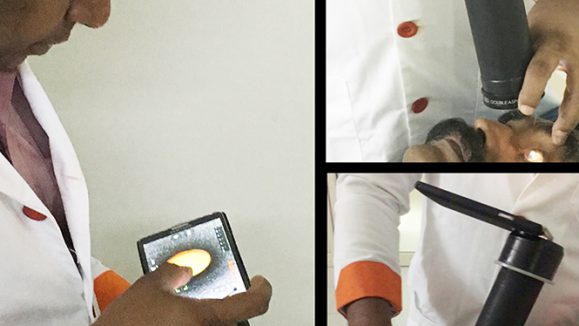Since inflammation has been suggested as a key factor for developing diabetic macular edema (DME), intravitreal corticosteroids have entered the picture to treat this root cause. And one of these, dexamethasone (or DEX) – a type of synthetic glucocorticosteroid1,2 – is emerging as the medication of choice for treating DME.
To take a closer look at its efficacy and safety as a therapy, a group of 10 centers from around the world investigated intravitreal DEX implants for DME patients – specifically comparing patients who were treatment naïve versus those who were refractory to anti-VEGF treatments in a real-life setting. The results from this retrospective investigation – called the International Retina Group Real-Life 24 Month Multicentre (IRGRel-DEX) study4 – were published in January 2019 and presented at the Asia-Pacific Academy of Ophthalmology (APAO) 2019 Congress in March.
Dr. Adrian Fung, one of the study’s authors and the vitreoretinal fellowship director at Westmead Hospital in Sydney, Australia, reported results from the study, which spanned 24 months. The primary outcome measures of IRGRel-DEX were best corrected visual acuity (BCVA) changes at 24 months and changes in macular thickness (central subfield thickness or CST) in the 24 months after receiving intravitreal dexamethasone.
The secondary outcome measures were changes in BCVA at six and 24 months, the number of DEX implants used, and any additional rescue anti-VEGF or laser therapy. The researchers also recorded safety data including cataract surgery and rising intraocular pressure.
To be eligible for the study, patients either had to have intravitreal dexamethasone treatment or be refractory to treatment – meaning they received at least three-monthly anti-VEGF injections, lost two or more lines of vision, or had a less than 10% percent reduction in CST. Patients’ BCVA had to be between 6/9.5 and 6/60. They also needed to have had center-involving DME, with either subretinal or intraretinal fluid and 24 months of follow-up.
Overall, 130 patients with a mean age of 69 years and an average HbA1c of 8.4% were included in the study. There were 71 patients in the treatment naïve group and 59 in the refractory group.
Over 24 months, all patients received a significant amount of intravitreal dexamethasone: The naïve group received almost four times (3.9) of treatment, while the refractory group received 3.1 times of the treatment. The patients could also have additional therapy, with refractory patients allowed anti-VEGF in addition to the DEX implant – on average, these patients received 10 anti-VEGF injections during the 24-month period.
The chemistry of the DEX implant in both groups of DME patients produced interesting results in terms of functional and anatomical outcomes.
BCVA showed a statistically significant difference between the refractory and the naïve groups: Not only did the naïve group gain 11.3 ± 10.0 letters versus the refractory group’s 7.3 ± 2.7 letters (P = 0.01), they were more likely to gain ≥10 letters. The investigators found that CST was significantly decreased compared with baseline in both groups, and although CST was higher in refractory eyes than in naïve eyes (CST 279 ± 61 vs. 313 ± 125µm, P = 0.10), it was not statistically significant.
Dr. Fung said: “In terms of baseline changes, there was a statistically significant difference between naïve and refractory eyes. The refractory eyes tended to have had prior focal laser or panretinal photocoagulation (PRP), and these factors were adjusted for in the statistical analysis.”
No patients required surgery for intraocular pressure-lowering treatment; however 7.1% of naïve and 22.8% of refractory patients received intraocular pressure-lowering topical therapy.
At the end of the study, results showed positive effects on patients’ functional and anatomical conditions (with a low rate of intraocular pressure-lowering therapy) among DME patients receiving DEX implants.
“There was also a suggestion that earlier treatment, in other words, patients who received treatment when they were naïve, tended to do better than patients who have had any previous VEGF therapy or refractory treatment,” explained Dr. Fung. Overall, he said that this study’s findings are consistent with previous real-life studies on DEX implants in DME patients.5-7
Editor’s Note: The APAO 2019 Congress was held in Bangkok, Thailand, on March 6-9, 2019. Reporting for this story also took place at APAO 2019. Media MICE Pte Ltd, PIE Magazine’s parent company, was the official media partner at APAO 2019.
References:
1 Dexamethasone. Drug Information. Available at: https://www.drugs.com/mtm/dexamethasone-ophthalmic.html
2 Dexamethasone. WebMD. Available at: https://www.webmd.com/drugs/2/drug-75004/dexamethasone-ophthalmic-eye/details
3 Pareja-Ríos A, Ruiz-de la Fuente-Rodríguez P, Bonaque-González S, et al. Intravitreal dexamethasone implants for diabetic macular edema. Int J Ophthalmol. 2018;11(1):77-82.
4 Iglicki M, Busch C, Zur D, et al. Dexamethasone implant for diabetic macular edema in naive compared with refractory eyes: The international retina group real-life 24-month multicenter study. The IRGREL-DEX Study. Retina. 2019;39(1):44-451.
5 Escobar-Barranco JJ, Pina-Marín B, Fernández-Bonet M. Dexamethasone implants in patients with naïve or refractory diffuse diabetic macular edema. Ophthalmologica. 2015;233(3-4):176-185.
6 Guigou S, Pommier S, Meyer F, et al. Efficacy and safety of intravitreal dexamethasone implant in patients with diabetic macular edema. Ophthalmologica. 2015;233(3-4):169-175. 7 Malclès A, Dot C, Voirin N, et al. Real-life study in diabetic macular edema treated with dexamethasone implant (The Reldex Study). Retina. 2017;37(4):753-760.




